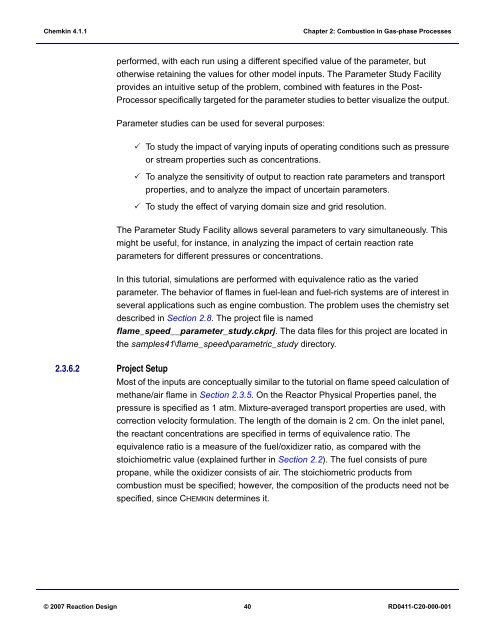Tutorials Manual
Tutorials Manual
Tutorials Manual
Create successful ePaper yourself
Turn your PDF publications into a flip-book with our unique Google optimized e-Paper software.
Chemkin 4.1.1<br />
Chapter 2: Combustion in Gas-phase Processes<br />
performed, with each run using a different specified value of the parameter, but<br />
otherwise retaining the values for other model inputs. The Parameter Study Facility<br />
provides an intuitive setup of the problem, combined with features in the Post-<br />
Processor specifically targeted for the parameter studies to better visualize the output.<br />
Parameter studies can be used for several purposes:<br />
To study the impact of varying inputs of operating conditions such as pressure<br />
or stream properties such as concentrations.<br />
To analyze the sensitivity of output to reaction rate parameters and transport<br />
properties, and to analyze the impact of uncertain parameters.<br />
To study the effect of varying domain size and grid resolution.<br />
The Parameter Study Facility allows several parameters to vary simultaneously. This<br />
might be useful, for instance, in analyzing the impact of certain reaction rate<br />
parameters for different pressures or concentrations.<br />
In this tutorial, simulations are performed with equivalence ratio as the varied<br />
parameter. The behavior of flames in fuel-lean and fuel-rich systems are of interest in<br />
several applications such as engine combustion. The problem uses the chemistry set<br />
described in Section 2.8. The project file is named<br />
flame_speed__parameter_study.ckprj. The data files for this project are located in<br />
the samples41\flame_speed\parametric_study directory.<br />
2.3.6.2 Project Setup<br />
Most of the inputs are conceptually similar to the tutorial on flame speed calculation of<br />
methane/air flame in Section 2.3.5. On the Reactor Physical Properties panel, the<br />
pressure is specified as 1 atm. Mixture-averaged transport properties are used, with<br />
correction velocity formulation. The length of the domain is 2 cm. On the inlet panel,<br />
the reactant concentrations are specified in terms of equivalence ratio. The<br />
equivalence ratio is a measure of the fuel/oxidizer ratio, as compared with the<br />
stoichiometric value (explained further in Section 2.2). The fuel consists of pure<br />
propane, while the oxidizer consists of air. The stoichiometric products from<br />
combustion must be specified; however, the composition of the products need not be<br />
specified, since CHEMKIN determines it.<br />
© 2007 Reaction Design 40 RD0411-C20-000-001
















